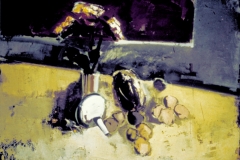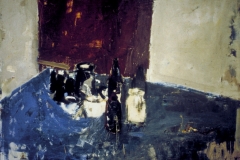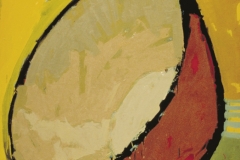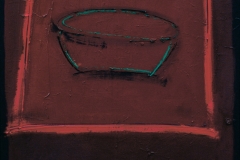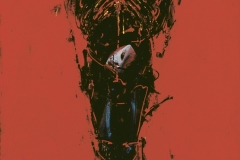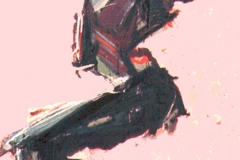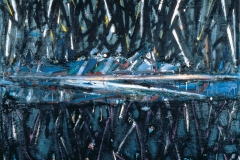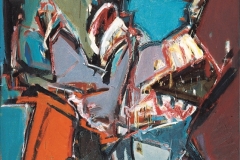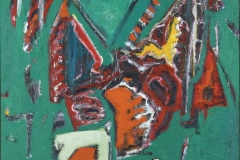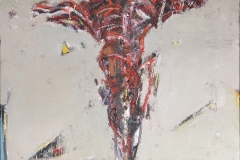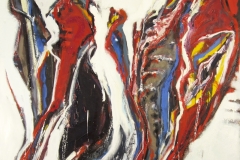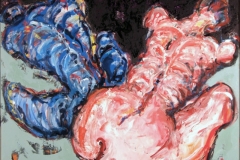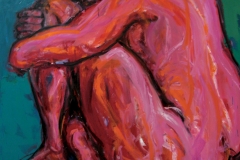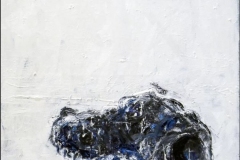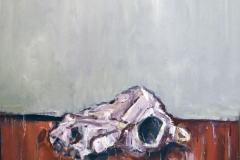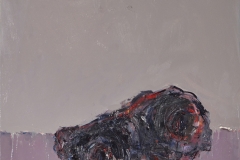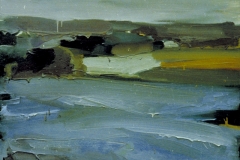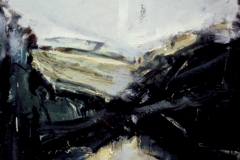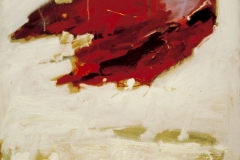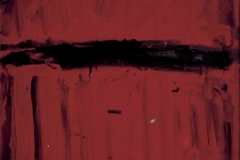Welcome to Andrzej Siwkiewicz web portal
Introduction
Born in Poland, Andrzej Siwkiewicz received his MFA in painting, sculpture and printmaking from the Academy of Fine Arts in Warsaw and an MFA in painting and printmaking from the RIT School of Art and Design, Rochester, NY. While in Rochester along with working on his graduate thesis Andrzej Siwkiewicz curated a number of shows, including solo exhibitions of late Walter Prochownik, an upstate NY artist, as well as Judd Lawrence Williams and a young Serbian artist Endi Poskovic among others.
In 1996 Siwkiewicz moved to Cleveland where he opened his painting and printmaking studio in the old textile warehouse district. Since then he has been exhibiting in local and regional venues. At its inception he joined CAAW (City Artists At Work), a local group of artists along the Superior Arts District in downtown Cleveland, supporting local art community as well as art education and outreach.
Working in collaboration with CSU Art Gallery Andrzej Siwkiewicz curated a show On The Other Side featuring artists of such disparate backgrounds as Kam Shun Lee from China, Yong Han of Korea, Tracy Heneberger from NYC and himself.
While his work from the 1990s often concerned dramatic world events such as Balkan wars and violence and atrocities in the context of human experience, his work in the 2000s was returning more to his interest of exploring individual relationships and existential contradictions through the human figure, including live studies. His more recent paintings focus on human figure studies, still lifes and spacial studies, inspired by landscape and interiors themes. His work is in private collections in Europe, the U.S. and Canada.
Some connect Siwkiewicz’s work to a sensibility in Polish Modernism that is coincident with the Neo-Expressionists in Western Europe and the United States. Siwkiewicz’s work explores personal and universal aspects of humanity as a whole as well an individual. He deals with concepts of isolation, boundaries and transgressions and violations of thereof. Inspired by European art of the early 20 century to American post war movements and late 20th century masters, he pursues his own vocabulary and esthetics within traditional media of painting, drawing and intaglio printmaking.
As New York art critic Robert Morgan noted in Siwkiewicz’s Chicago solo show catalog “his paintings often offer a fragmented metaphor of the body in an arbitrary psychic space. The formal relationships between the pictorial elements are tightly bound to the surface, thereby offering a tension between the elements that elicits a vision of inner-chaos, a turbulence that is inexorable and unmistakable in its coercion. The visceral impact in the work of Siwkiewicz is the issue at large. To receive the thought behind these paintings is to empathize with the artists struggle in securing a sense of ones cultural identity in an increasingly abstract world.”
About

Europa Series
Acts of transgressions have irreversible consequences, often tragic and senseless. They happen every day to everybody directly and indirectly. We live in times of perpetual conflict. By responding to it, art may have the potential to transcend its own artificiality and context.
The Europa Series attempts to confront the context, manifestation, impact and personalization of conflict, transgressions and violence. The series comprises of a number of oil paintings initially triggered by recent European conflicts. Its initial groundwork was based on figurative imagery that underwent a process of reduction and fragmentation through separation of the content. A painting resolved this way without explicitly invoked narrative, but affected by the physicality of the process may then present an ambiguous perspective on violence as an organized, aesthetically satisfactory abstraction, when transgressions and conflict are repressed within our cultural conditioning while seeking refuge in socially acceptable interpretations.
On a personal level, the act of applying paint with brush, knife, rag or hands is a physical activity with its inherent ambiguities and visceral connotations. At the same time our own physiological banality clashes with spiritual and mental alienation, as a constant variable of life.
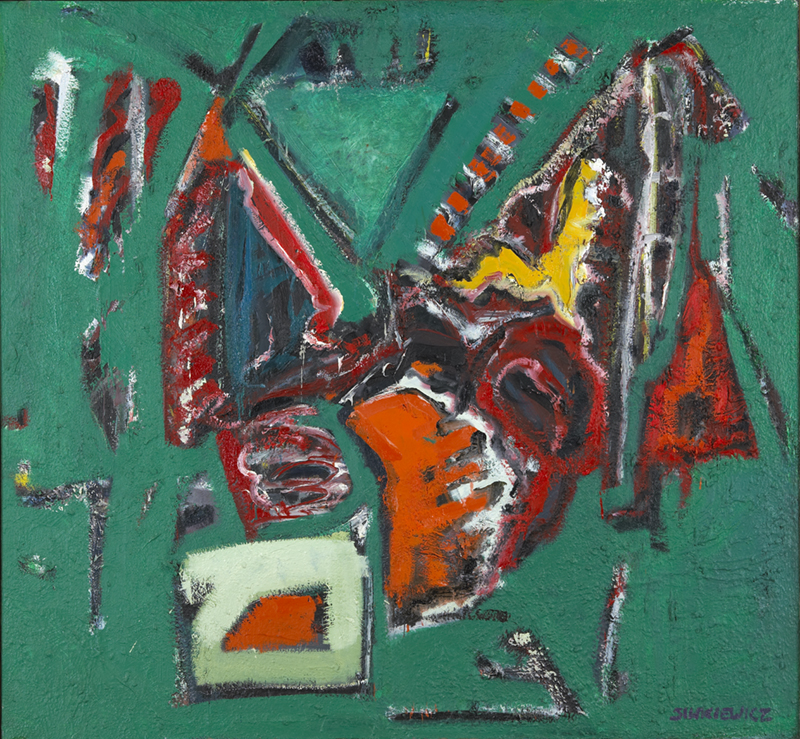
Paradise Series
The series is inspired by Milton’s poem and T.S. Eliot select works. It concerns human isolation, the temptation of the physical and the carnal and attempts to find balance, moral and existential center and meaning. Human figure and its references may present themselves as potent vehicles to examine basic ontological questions. The figuration may beget symbolic connotations on personal level, as there is no narrative imposition. The emotional content does not exclusively define the work, though hopefully guides it toward clearer exposition.
Reviews
ANDRZEJ SIWKIEWICZ: Paintings of Visceral Abstraction
fix this pothook of beauty on this palette
you never know it might be final
Samuel Beckett, Serena III
Andrzej Siwkiewicz, a Polish artist living in upstate New York, has been painting for the past few years in a style of figurative abstraction. His work is connected to a sensibility in Polish Modernism that is coincident with the Neo-Expressionists in Western Europe and the United States.
Over the past three years, Siwkiewicz’s representation of the figure has been in a perpetual state of a dissemblance. One is more apt to see the paintings as an abstract field where biomorphic and geometric shapes interact and collide against one another. In fact, these shapes are visceral signifiers that constantly refer back to the human figure.
In 1992, Siwkiewicz was working with two primary themes: bowls and figures. (Earlier he had been painting the human figure and bowls in the same composition.) Using a stylistic means of interpretation, the artist began seeking an object-to-ground relationship. In the paintings of bowls the elliptical shapes hover against a spatial field, as in (Big) Bowls on Yellow, Red, and Blue; while the paintings of abstract figures are more elongated and, in some cases, divided, as in Split (1993). These paintings are essentially metaphysical in their orientation. They have a certain refinement and symbolic content.
The expressive point of view changed in Siwkiewicz’s paintings in late 1993 as the visual structure of the surface began to explode into a dense configuration of color and shape. Taking on the tragic character of Greek drama, paintings such as Groinkickers and Groins (Beheaded) reveal a certain overdetermination whereby the ego projects itself into the dark chaos of metaphysical abstraction.
These paintings offer a fragmented metaphor of the body in an arbitrary psychic space. The formal relationships between the pictorial elements are tightly bound to the surface, thereby offering a tension between the elements that elicits a vision of inner-chaos, a turbulence that is inexorable and unmistakable in its coercion.
The picture plane is thus destroyed as a purely conceptual structure. The dissemblance of the body as a psychic projection takes over and crowds the space, conflating the logic of both mind and body.
The pictorial field is transformed into a symbolic nexus of thrusts and counter-thrusts building a composition that is indeterminate, yet aggressively defined.
Like the painter Hans Hofmann, Siwkiewicz pays attention to the construction of the surface, the formal continuity of the shapes, the complexity of form in relation to the space. In contrast to Hofmann, the recent paintings of Siwkiewicz appear less resolved in a theoretical manner and more open to what might be considered as a metaphorical resonance.
The splaying of the figure as a discharge of psychic oppression suggests an action that is given to repetition, a form of visual aggressivity. In a painting, such as Stranglers (1994), one is unlikely to find a resolution in the conventional sense. Rather the viewer is more likely to be confronted and provoked by the artist’s visualization of unconscious violence.
The painterly aspect of these works describes the process of the artist’s thought; yet the thought behind or within this process is not exempt from involvement. The visceral impact in the recent work of Siwkiewicz is the issue at large. To receive the thought behind these paintings is to empathize with the artist’s struggle in securing a sense of one’s cultural identity in an increasingly abstract world.
Robert C. Morgan 1995
International Artist Displays Paintings in Tremont Gallery
by Kimberly Tilley
Volume 3, Issue 6, Posted 2:59 PM, 03.12.2007
Springtime has brought a welcome renewal to the Cleveland art scene. Tremont’s new gallery, exit (a gallery space), is hosting a unique exhibition of paintings by Andrzej Siwkiewicz through March 31. The exhibit, collectively titled “Apart – From Europa to Paradise,” consists of six paintings, which comprise years of work on the artist’s part.
A native of Poland, Siwkiewicz has been exhibiting artwork since the 1970s, both in private collections and public museums. Despite being a respected artist throughout Europe, Siwkiewicz was virtually unknown when he came to the United States in the early 1990s. “You have to start from scratch,” he says philosophically. Though he has done well in the United States and Europe, fame is not among Siwkiewicz’s priorities. Rather, he is in love with the different aspects of his work. “Physicality and material are things I strongly identify with,” he explains.
Yet, Siwkiewicz enjoys the mental process of painting as much as the physical side. “For me, art is a dialogue, not an execution. It’s not always what you considered first that really works.” Siwkiewicz strives to defy the status quo. “You have to keep yourself on edge. You don’t want to be redundant. If you’re going to repeat yourself, why bother?” This is important because of art’s role in society, Siwkiewicz explains. “We are in constant change and it’s important to recognize and identify this, and to somehow articulate this with the means we have. Art is a venue for self-expression.”
Unlike many artists, Siwkiewicz shies away from identifying himself with a particular style of art. “You cannot explain art. You either connect with it or not, so I don’t try to interpret my paintings for others. I want people to respond to my work, but I’m not going to guide them by giving them a name or a classification for it. People must trust their instincts.”
The choice of venue is deliberate. Siwkiewicz is adamant when he explains the importance of selecting the right place for an exhibit. “Context is important. The wrong context can question your integrity and demeans the work. The venue defines your intentions. The sole purpose is not to sell the paintings, but to create a dialogue, to create a connection.” The exit (a gallery space) was formerly located in Kent, Ohio, and relocated to 2688 W. 14th St. in Tremont last August.
Andrzej Siwkiewicz: Apart – From Europa to Paradise
From: Exit Gallery
Andrzej’s first
solo show at exit (a gallery space) will encompass works selected from the
Europa, Separations and Paradise Lost series.
While the Europa series had specific references to the recent social and
political events, it deals with them on a very personal, visceral level. States
of isolation, depravation, humiliation and senseless loss are often the subject
of these works. The Separations series explores more intimate emotional
conditions, which often stem from communication barriers or predisposed
limitations. Finally, the Paradise Lost series attempts to address the
transient, fleeting manifestations of life, hopes, ambitions, and their
inevitable demise and collapse. The underlying theme of these works is often
revolving around a perverse sense of inability to reconcile inherent
contradictions between cultures, individuals and self, while driven by a
passion and empathy for the disempowered and deprived.
Andrzej was born in Warsaw, Poland and holds two MFA’s, first in painting,
printmaking and sculpture from the Academy of Fine Arts in Warsaw, and second,
an MFA from the School of Art and Design of the Rochester Institute of
Technology, Rochester, NY, were he briefly taught art. Andrzej relocated to
Cleveland in 1996 where he maintains a studio in the St. Vincent Quadrangle
neighborhood and is a member of a local art advocacy group City Artists at Work
of the Superior Corridor.
Andrzej has exhibited both nationally and internationally and had a catalog of
his works authored by a noted art critic and writer Robert C, Morgan. Andrzej’s
works can be found in collections in the US, Canada, Poland, Germany, Norway,
Holland, Great Britain, France and Spain.
March 9th – March 31st 2007.
Exhibit showcases cultural differences through artwork
By Mike Soltesz
A new exhibit displaying artwork called “On The Other Side” showcases four artists who represent different backgrounds while operating in new environments that are different from their own cultures. It will be open May 29 and runs through June 27 at the Cleveland State Art Gallery.
There are four artists in the exhibit, Tracy Heneberger, Kam Shun Lee, Yong Han, and Andrzej Siwkiewicz.
Dr. Robert Thurmer, the director of the Cleveland State Art Gallery, says the exhibit shows the art has a “cross-cultural component to them.” “The idea is that all of these artists spent their formative years in one culture and are now producing art in and for a different culture,” he said.
Lee is from China and he now lives in Cleveland and does most of his work here. Yong Han, who is from South Korea used to live in Cleveland and now works in Connecticut. Siwkiewicz, who is also the curator, was born and grew up in Poland and now lives in Cleveland.
Heneberger is the only American-born artist whose work is in the exhibit. He lives in Brooklyn, N.Y. but has done work and exhibits in China. Most of the work is in China. He was included because he is the only American in the exhibit.
Thurmer says that the themes that are being explored in the show are subtle and interesting because artists who come into this country come with a new set of aesthetics.
He says that the styles and cultures the artists come from are completely different from America and that it has an impact on their work. “We ask the question of how does this influence their work,” he said.
He says that the set of circumstances in America are different from others. Thurmer grew up in Austria and he used to work in a room no bigger than a little closet. “The physical circumstances of an artist can have an impact on their work,” he said.
Siwkiewicz says that the exhibit is exploring eastern and western sensibility on culture. He thinks that the works are “interesting personal narratives” and that they show who the artists “are as individuals.”
He also thinks that this is quite a unique show. “There’s not a show like this, it’s an interesting attempt to explore Cleveland and what is beyond just what local artists do,” he said.
Taking Sides
CSU Gallery breaks on through with four artists
By Douglas Max Utter
On the Other Side Through June 27 CSU Gallery 2307 Chester Ave. 216.687.2103 csuohio.edu/artgallery
On the Other Side, a show of large-scale painting and wall-mounted sculpture now on display at the Cleveland State University Art Gallery, is a time-traveling exhibit of works, a few of which feel like they dug in their heels back during some fraught, neo-expressionist moment in the 1980s.
That in itself isn’t a bad thing; much of the most ambitious expressive work of the century flourished (however improbably) during the Reagan administration. And it’s undeniably the business of this kind of art to find the power and passion immanent in materials. The only relevant questions for artist and viewer alike are always the same: Is it working? Are we feeling yet? But if the words “What year is this?” are hard to repress, there may be a problem. Feeling is so much a matter of the present tense.
On the Other Side curator Andrzej Siwkiewicz is a Polish-born painter who relocated to New York in the late 1980s, moving to Cleveland in 1996. At the CSU Gallery, he adds four large-scale oil paintings of his own to the mix — boldly rendered images of nude female models striking self-absorbed poses, as in “R & R,” which shows two figures essentially back-to-back. In the foreground, one crouches in shadow, facing us and gazing down at her hands planted on the floor; the other is modeled in strokes of light pink and white and is shown from the back, with one hand raised to the nape of her neck. A vibrant red and pink background offers no information about the figures but serves to frame a muscular evocation of frustration and distraction.
The show’s tendency toward the dramatic is even more pronounced in Yong Han’s two nearly 10-foot works, “Lion King” and “Bondage.” The Korean-born artist has become one of Cleveland’s most recognizable painters in the past two decades, combining loose abstraction with a kind of celebratory geometry in huge oil-on-canvas works. In the past he has used a Christmas tree-like triangle as organizational/symbolic motif, and here, starbursts of radiating yellow and white lines serve a similar function. The overall effect is a taut sense of possibility, as Yong’s layered imagery draws the viewer toward a mysterious vision of house-like shapes, glimpsed through the bars of a cage of energy.
Kam Shun Lee moved to the U.S. from China with his family as a teenager. Like Yong Han, he has become a notable presence in Cleveland painting, especially during the 1990s. His athletic depictions at the CSU gallery of dense vegetation, rocks and other landscape elements read as much like acts of pure painting as depiction, reveling in substance and the formal rhythms of mark-making.
Most contemporary — because he’s the least time-bound of the artists in On the Other Side — is American sculptor Tracy Heneberger. Over the past decade, Heneberger has traveled back and forth many times to produce works at a foundry in Beijing, where his experiences have inspired his wall-hanging bronze and aluminum objects, cast from actual fish, mushrooms and medicinal roots. Metaphorical works like the fan-like “Chorus” and the uneven, frayed-looking “Tapestry” — both assembled from a number of bronze fish — stir different sensory experiences and associations together, ambushing expectation. Heneberger’s powerfully contemplative combinations speak of transformation and the great cycle of ages that spins out all forms, so briefly cast in time.

